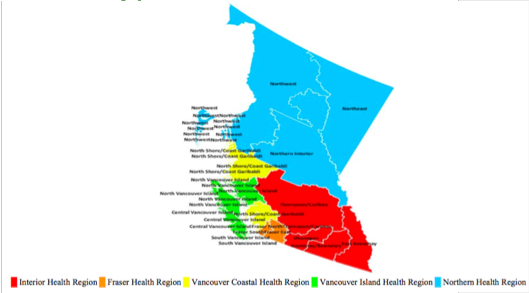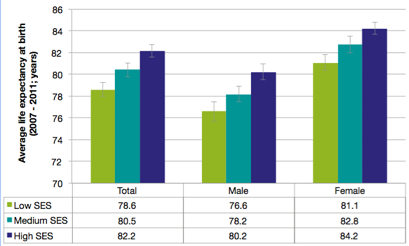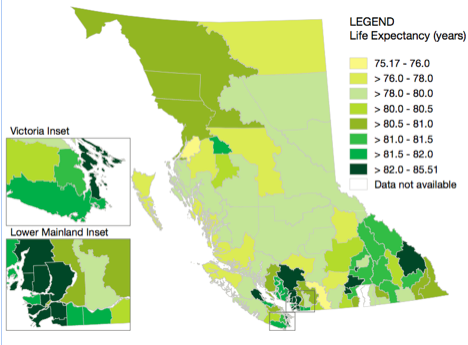"Northern Factors" and Women's Health

On This Page:
- Northern Factors and Women's Health
- Map 1: Health geographies in British Columbia
- Table 1: Age standardized prevalence rates in British Columbia in 2006/2007
- Health Inequity Indicators
- Map 2: Life expectancy at birth for the total British Columbia populations, by Local Health Areas, 2007 - 2011
- Additional Resources
Northern Factors' and Women's Health
Northern, rural, and remote areas provide definite health advantages such as:
- Opportunities for sport and recreation,
- Easier access to nature,
- Food security,
- Proximity to fresh food producers,
- And many more.
However, it has been made clear that these benefits do not outweigh the costs; with northern, rural and remote regions having been rated poorly on nearly all measures of health indicators in British Columbia. This demonstrates that health care for these communities are compromised of distance, environment, economic expenses (e.g., travel costs), and by the limited services. Out of the services that do exist in northern, rural and remote communities, several are unable to provide the best care due to several issues, such as lack of resources, being underfunded, and having problems maintaining staff.
Health care services in British Columbia are divided into five regional areas: Interior Health Region, Fraser Health Region, Vancouver Coastal Health Region, Vancouver Island Health Region and Northern Health Region. Each region has health authorities that are responsible for providing and governing health services for their respective area. Refer to Map 1 for a visual representation of the five regions.
Map 1
Health geographies in British Columbia

Note. Map 1 is courtesy of Provincial Health Services Authority. 2010.
Examining the prevalence rates of different health conditions by region allows for a direct comparison to be made between the regions. Specifically if the prevalence rates are age-standardized. Refer to Table 1 for a comparison of health conditions in the Northern Health Region compared to the average of British Columbia.
Table 1
Age standardized prevalence rates in British Columbia in 2006/2007

Note. Red = Higher than B.C. average; Blue = Lower than B.C. average. Adapted from Table 19 in “Summary Report on Health for British Columbia from Regional, Longitudinal and Gender Perspectives. Provincial Health Services Authority” by Provincial Health Services Authority, 2010, p. 51.
Health Inequity Indicators
Life expectancy is an internationally recognized measurement tool that determines the average number of years that a person in a particular region is expectancy, gender and socio-economic status. Figure 1 demonstrates connection in British Columbia.
Figure 1
Life expectancy at birth (2007 - 2011) by socio-economic status index (2011) for the total population in British Columbia, and by sex.

Note. Figure 1 is courtesy of Provincial Health Services Authority. 2016. Source of information from: Zhang & Rasali, 2015.
While examining Figure 1, keep in mind that within British Columbia regions of higher reported socio-economic status are concentrated in southern area of the province. This is not to say that the central and northern areas are all low socio-economic status but rather that these areas are generally found to have low and medium socio-economic status (PHSA, 2016).
Life expectancy in Canada is competitive internationally, with Canadians experiencing one of the highest life expectancies in the world and British Columbia reporting the highest life expectancy across all of Canada (PHSA, 2016). Despite the high rates of expected life in British Columbia, statistical data demonstrates there are significant differences found in life expectancy across different regions in British Columbia. These differences allude to the existence of health inequalities throughout the province. Refer to Map 2 for a visual representation of life expectancy for the B.C. population by geographical region.
Map 2
Life expectancy at birth for the total British Columbia populations, by Local Health Areas (LHA), 2007 - 2011.

Note. Map 2 is courtesy of Provincial Health Services Authority. 2016.
References
Provincial Health Services Authority. (2010). Summary report on health for British Columbia from regional, longitudinal, and gender perspectives. Retrieved from: http://www.phsa.ca/Documents/bchealth_indicators_report.pdf
Provincial Health Services Authority. (2016). Priority health equity indicators for British Columbia: Selected indicators report. Retrieved from: http://www.bccdc.ca/pop-public-health/Documents/Priority health equity indicators for BC_selected indicators report_2016.pdf
Additional Resources
Health Indicators Interactive Tool for International and Provincial Comparisons (2016)
